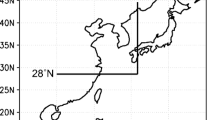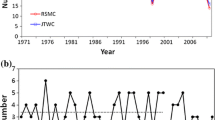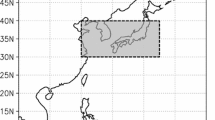Abstract
This study analyzed changes in tropical cyclone (TC) intensity for the past 62 years (1951–2012) by calculating annual average value of central pressure (CP) of TCs that affected the Philippines from July to September. Although TC intensity slightly weakened for the last 62 years, it was not statistically significant. In order to examine the causes of changes in intensity of TCs that influenced the Philippines, nine low CP years and nine high CP years among the 62 years were selected to analyze differences between the two groups. TCs largely occurred in the southeastern quadrant of tropical and subtropical western North Pacific during low CP years and tended to move to the Philippines from the far sea in the southeast of the nation. In differences in deep-layer-mean wind between the two groups, western North Pacific subtropical high (WNPSH) did not develop toward the middle latitudes of East Asia but toward the low latitudes of the region during low CP years. Therefore, TCs occurred in the southeastern quadrant of tropical and subtropical western North Pacific, triggering its movement of long distance westward toward the Philippines. As positive anomalies in precipitable water and at 600 hPa relative humidity, 850 hPa air temperature, and sea surface temperature continued to the Philippines from the southeastern quadrant, a favorable environment where intensity of TCs can be strengthened while they move to the Philippines during low CP years has been formed. In the end, because WNPSH developed toward the low latitudes during low CP years, anomalous easterlies that strengthened in the southern regions of WNPSH blew to the Philippines, and SST in the sea near the nation was heightened. Therefore, because TCs were able to obtain sufficient energy from the relatively warm sea while TCs moved a long distance to the Philippines, TC intensity was able to be strengthened.









Similar content being viewed by others
References
Chan JCL, Gray WM (1982) Tropical cyclone movement and surrounding flow relationships. Mon Weather Rev 110:1354–1374
Choi KS, Wu CC, Byun HR (2012) Possible connection between summer tropical cyclone frequency and spring arctic oscillation over East Asia. Clim Dyn 38:2613–2629
Chu PS, Clark JD (1999) Decadal variations of tropical cyclone activity over the central North Pacific. Bull Am Meteorol Soc 80:1875–1881
Emanuel K (2005) Increasing destructiveness of tropical cyclones over the past 30 years. Nature 436:686–688
George JE, Gray WM (1976) Tropical cyclone motion and surrounding parameter relationships. J Appl Meteorol 15:1252–1264
Graham NE (1994) Decadal-scale climate variability in the tropical and North Pacific during the 1970s and 1980s: observations and model results. Clim Dyn 10:135–162
Ho CH, Baik JJ, Kim JH, Gong DY (2004) Interdecadal changes in summertime typhoon tracks. J Clim 17:1767–1776
Ho CH, Kim JH, Kim HS, Sui CH, Gong DY (2005) Possible influence of the antarctic oscillation on tropical cyclone activity in the western North Pacific. J Geophy Res 110: doi:10.1029/2005JD005766
Kalnay E (1996) The NCEP/NCAR 40-year reanalysis project. Bull Am Meteorol Soc 77:437–471
Kistler R (2001) The NCEP/NCAR 50-year reanalysis. Bull Am Meteorol Soc 82:247–267
Knutson TR (2010) Tropical cyclones and climate change. Nat Geosci 3:157–163
Kubota H, Chan JCL (2009) Interdecadal variability of tropical cyclone landfall in the Philippines from 1902 to 2005. Geophy Res Let 36:10.1029/2009GL038108
Landsea CW (2007) Counting Atlantic tropical cyclones back to 1900. Eos 88:197–208
Mantua NJ, Hare SR, Zhang Y, Wallace JM, Francis RC (1997) A Pacific interdecadal oscillation with impacts on salmon production. Bull Am Meteorol Soc 78:1069–1079
NOAA National Climatic Data Center (2013) State of the climate: hurricanes and tropical storms for annual 2013
Nitta T, Yamada S (1989) Recent warming of tropical sea surface temperature and its relationship to the Northern Hemisphere circulation. J Meteorol Soc Jpn 67:375–383
Reynolds RW, Rayner NA, Smith TM, Stokes DC, Wang W (2002) An improved in situ and satellite SST analysis for climate. J Clim 15:1609–1625
Trenberth KE (1990) Recent observed interdecadal climate changes in the northern hemisphere. Bull Am Meteorol Soc 71:988–993
Velden CS, Leslie LM (1991) The basic relationship between tropical cyclone intensity and the depth of the environmental steering layer in the Australian region. Weather Forecast 6:244–253
Webster PJ (2005) Changes in tropical cyclone number, duration, and intensity in a warming environment. Science 309:1844–1846
Weinkle JL, Maue R, Pielke R (2012) Historical global tropical cyclone landfalls. J Clim 25:4729–4735
Wilks DS (1995) Statistical methods in the atmospheric sciences. Academic Press, p 467
Wingo MT, Cecil DJ (2010) Effects of vertical wind shear on tropical cyclone precipitation. Mon Weather Rev 138:645–662
Yang WJ, Yi WH (2013) Safety evaluation of mansionary buildings for tsunami. J Korean Soc Hazard Mitig 13:45–49
Acknowledgements
This work was funded by the Korea Meteorological Administration and Development Program under Grant 2013-8050.
Author information
Authors and Affiliations
Corresponding author
Rights and permissions
About this article
Cite this article
Choi, KS., Kim, BJ., Kang, SD. et al. Interannual variation of the Philippines affecting tropical cyclone intensity and its possible causes. Theor Appl Climatol 122, 295–301 (2015). https://doi.org/10.1007/s00704-014-1281-1
Received:
Accepted:
Published:
Issue Date:
DOI: https://doi.org/10.1007/s00704-014-1281-1




